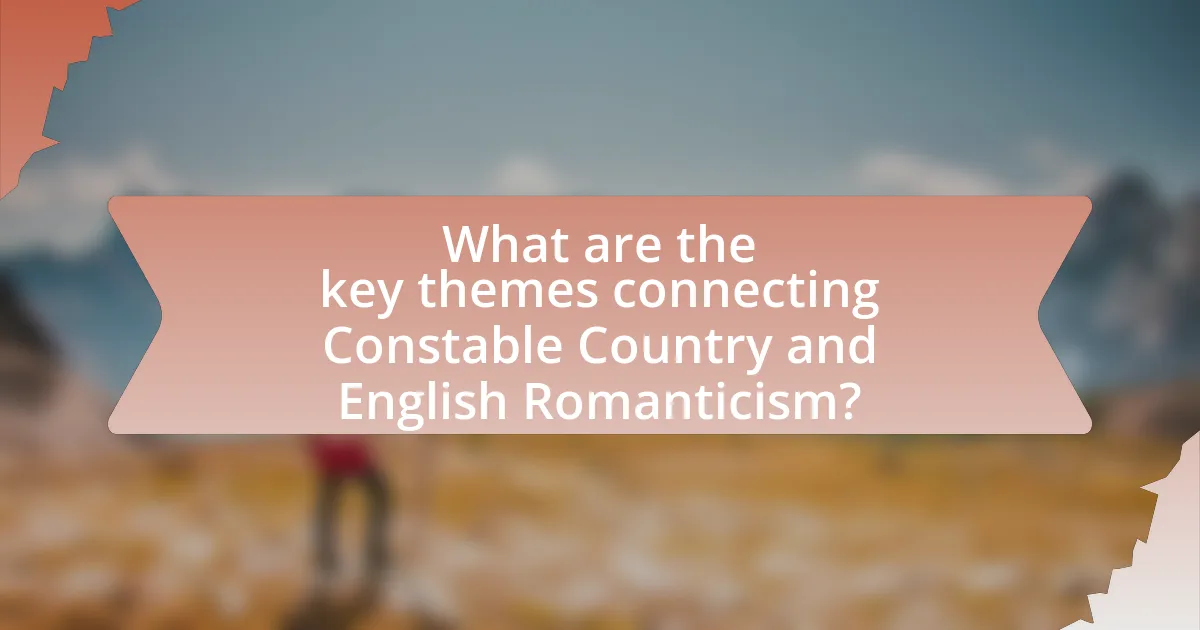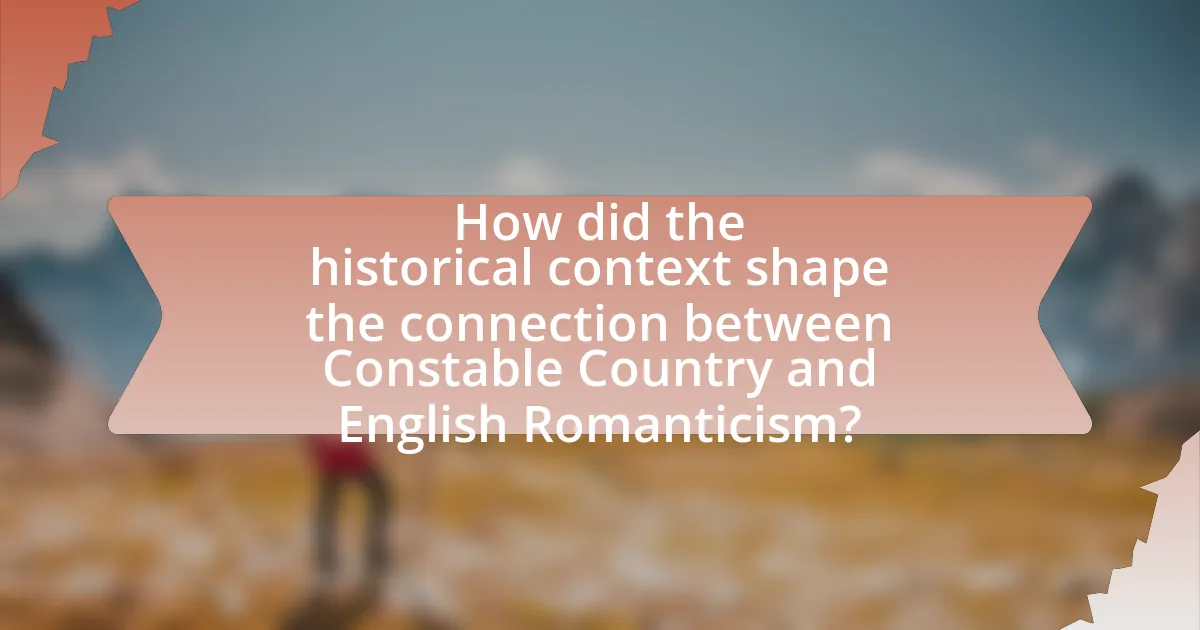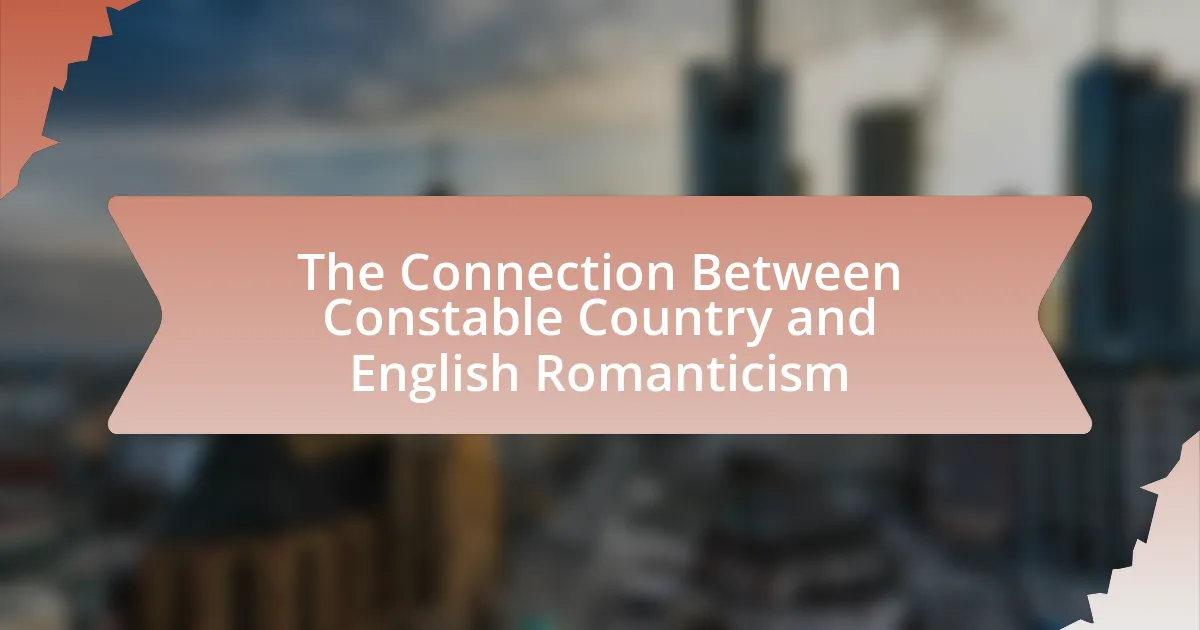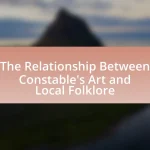Constable Country, associated with the artist John Constable, is closely linked to English Romanticism, reflecting the movement’s ideals of nature, emotion, and individual experience. The article explores how Constable’s landscape paintings, particularly those of Suffolk, embody the Romantic emphasis on the beauty and emotional depth of the natural world, influencing contemporaneous artists and poets. Key themes include the portrayal of the sublime, the idealization of rural life, and the emotional responses evoked by nature, illustrating how Constable’s work aligns with Romantic principles and serves as a significant representation of the movement. Additionally, the historical context of the Industrial Revolution and Constable’s personal experiences further shaped this connection, highlighting the enduring impact of his art on Romantic literature and culture.

What is the Connection Between Constable Country and English Romanticism?
Constable Country is intrinsically linked to English Romanticism through its embodiment of nature’s beauty and emotional depth, as exemplified in the works of artist John Constable. Constable’s paintings, particularly those depicting the landscapes of Suffolk, reflect the Romantic ideal of finding sublime beauty in the natural world, emphasizing emotional resonance and personal experience. His use of light, color, and texture captures the changing moods of the landscape, aligning with Romanticism’s focus on individual perception and the emotional response to nature. This connection is further validated by the fact that Constable’s work inspired later Romantic artists and poets, who sought to express similar themes of nature and emotion in their own creations.
How did Constable Country influence the Romantic movement in England?
Constable Country significantly influenced the Romantic movement in England by embodying the ideals of nature, emotion, and individual experience that were central to Romanticism. John Constable’s landscape paintings, particularly those depicting the Suffolk countryside, emphasized the beauty and emotional resonance of the natural world, which resonated with Romantic artists and poets who sought to express deep feelings and a connection to nature. His work, characterized by a focus on light, atmosphere, and the changing seasons, inspired contemporaries like William Wordsworth and Samuel Taylor Coleridge, who valued the sublime and the personal experience of nature. Constable’s dedication to capturing the essence of rural life and the emotional depth of landscapes contributed to the broader Romantic ethos, reinforcing the movement’s emphasis on the importance of nature as a source of inspiration and reflection.
What are the key characteristics of Constable Country that resonate with Romantic ideals?
Constable Country embodies key characteristics that resonate with Romantic ideals, including an emphasis on nature, emotional expression, and the sublime. The landscape features rolling hills, lush fields, and tranquil rivers, reflecting the Romantic fascination with the beauty and power of nature. John Constable’s paintings, such as “The Hay Wain,” evoke deep emotional responses through their vivid depictions of rural life and the changing seasons, aligning with the Romantic focus on individual feelings and experiences. Additionally, the portrayal of the sublime in Constable’s work, where nature is both beautiful and awe-inspiring, captures the Romantic ideal of finding transcendence in the natural world. These elements collectively illustrate how Constable Country serves as a quintessential representation of English Romanticism.
How did John Constable’s works reflect the principles of Romanticism?
John Constable’s works reflect the principles of Romanticism through their emphasis on emotion, nature, and individual experience. His paintings, such as “The Hay Wain,” showcase the beauty of the English countryside, highlighting the emotional connection between humans and nature, a core tenet of Romanticism. Constable’s use of light and color evokes feelings of nostalgia and tranquility, aligning with the Romantic ideal of expressing deep personal feelings and the sublime aspects of nature. Additionally, his focus on rural life and the depiction of atmospheric conditions demonstrate a departure from the industrialization of his time, reinforcing the Romantic valorization of the natural world over urbanization.
Why is Constable Country significant in the context of English Romanticism?
Constable Country is significant in the context of English Romanticism because it embodies the movement’s emphasis on nature, emotion, and individual experience. John Constable, the prominent painter associated with this region, captured the English landscape with a focus on its beauty and emotional resonance, reflecting Romantic ideals. His works, such as “The Hay Wain,” illustrate the connection between humanity and nature, showcasing the pastoral scenes of Suffolk that evoke feelings of nostalgia and tranquility. This alignment with Romanticism is further supported by Constable’s innovative techniques, such as his use of light and color, which enhanced the emotional depth of his landscapes, making them a vital part of the Romantic narrative in art.
What role did nature play in the Romantic interpretation of Constable Country?
Nature served as a central theme in the Romantic interpretation of Constable Country, emphasizing emotional depth and the sublime beauty of the English landscape. Romantic artists, including John Constable, depicted nature not merely as a backdrop but as a living entity that evokes feelings of nostalgia, tranquility, and awe. Constable’s works, such as “The Hay Wain,” illustrate this connection by showcasing the harmony between rural life and the natural environment, reflecting the Romantic ideal of finding beauty and inspiration in the everyday landscape. The emphasis on light, atmosphere, and the changing seasons in his paintings further reinforces the notion that nature is a source of emotional and spiritual resonance, aligning with Romantic beliefs that prioritize individual experience and the sublime qualities of the natural world.
How did the landscape of Constable Country inspire Romantic poets and writers?
The landscape of Constable Country inspired Romantic poets and writers by providing a vivid representation of nature that emphasized emotional depth and individual experience. This region, characterized by its pastoral scenes, rolling hills, and serene waterways, resonated with the Romantic ideal of finding beauty and truth in the natural world. Notably, John Constable’s paintings, such as “The Hay Wain,” captured the essence of rural life and the changing seasons, which influenced contemporaneous poets like William Wordsworth and Samuel Taylor Coleridge. Their works often reflected similar themes of nature’s beauty and the human connection to it, showcasing how Constable Country served as a muse for exploring the emotional and spiritual dimensions of the landscape.

What are the key themes connecting Constable Country and English Romanticism?
The key themes connecting Constable Country and English Romanticism include the celebration of nature, emotional expression, and the idealization of rural life. Constable’s landscape paintings, particularly those depicting the Suffolk countryside, reflect the Romantic emphasis on the beauty and emotional power of nature, showcasing the interplay of light and atmosphere. Additionally, the Romantic movement valued individual experience and emotion, which is evident in Constable’s work as he sought to convey personal feelings through his depictions of the landscape. The idealization of rural life, a common theme in Romantic literature and art, is also present in Constable’s focus on pastoral scenes that evoke a sense of nostalgia and simplicity, contrasting with the industrialization of the time. These themes collectively illustrate how Constable’s art embodies the principles of English Romanticism, emphasizing a deep connection to the natural world and human emotion.
How does the theme of nature manifest in both Constable’s work and Romantic literature?
The theme of nature manifests in both Constable’s work and Romantic literature through an emphasis on the beauty, emotional resonance, and spiritual significance of the natural world. Constable’s paintings, such as “The Hay Wain,” depict rural landscapes with meticulous attention to light and atmosphere, reflecting the Romantic ideal of nature as a source of inspiration and solace. Similarly, Romantic literature, exemplified by poets like Wordsworth and Coleridge, celebrates nature as a powerful force that evokes deep emotional responses and serves as a backdrop for personal reflection and transcendence. Both Constable and Romantic writers convey a profound connection to nature, illustrating its role in shaping human experience and fostering a sense of belonging within the natural world.
What specific elements of nature are highlighted in Constable’s paintings?
John Constable’s paintings prominently highlight elements such as clouds, trees, rivers, and rural landscapes. His works often depict the changing weather and atmospheric conditions, particularly through the use of dramatic cloud formations, which convey a sense of movement and emotion. Additionally, Constable’s focus on the English countryside showcases the beauty of natural elements like lush greenery, flowing water, and pastoral scenes, emphasizing the harmony between nature and human life. This attention to detail and realism in portraying nature reflects the ideals of English Romanticism, which values the sublime and the picturesque in the natural world.
How do these elements compare to those found in Romantic poetry?
The elements of Constable Country, characterized by a focus on nature, emotion, and individual experience, closely align with those found in Romantic poetry. Both emphasize the beauty of the natural landscape and evoke deep emotional responses, reflecting the Romantic ideal of nature as a source of inspiration and solace. For instance, John Constable’s paintings often depict the English countryside in a way that mirrors the themes of longing and nostalgia prevalent in the works of Romantic poets like William Wordsworth and Samuel Taylor Coleridge. This connection is evident in the shared appreciation for the sublime and the personal connection to nature, which serves as a backdrop for exploring human emotions and experiences.
What emotional responses are evoked by Constable Country in Romantic art and literature?
Constable Country evokes feelings of nostalgia, tranquility, and a deep appreciation for nature in Romantic art and literature. The landscapes depicted by John Constable, characterized by their lush greenery and serene rural scenes, resonate with the Romantic ideal of finding beauty and solace in the natural world. This emotional response is reinforced by the emphasis on personal experience and the sublime, as seen in Constable’s works like “The Hay Wain,” which captures the harmony between humanity and the pastoral environment. The emotional depth is further supported by the writings of Romantic poets such as William Wordsworth, who celebrated similar themes of nature and emotional connection, illustrating how Constable Country serves as a backdrop for exploring profound human feelings.
How do feelings of nostalgia and longing appear in Constable’s works?
Feelings of nostalgia and longing prominently appear in John Constable’s works through his depictions of the English countryside, particularly in his paintings of landscapes that evoke a sense of personal and collective memory. Constable often portrayed familiar scenes from his childhood in Suffolk, such as the Hay Wain and The Cornfield, which reflect an idealized vision of rural life that resonates with viewers’ yearning for a simpler, pastoral existence. This longing is further emphasized by his use of light and color to create a sense of warmth and tranquility, inviting the audience to reminisce about their own connections to nature and home. The emotional depth in Constable’s landscapes aligns with the themes of English Romanticism, where nature serves as a backdrop for human emotion and nostalgia, reinforcing the idea that these works are not merely representations of the physical world but also expressions of deep-seated feelings and memories.
What parallels can be drawn between these emotions and those expressed by Romantic poets?
Emotions expressed in Constable Country parallel those of Romantic poets through themes of nature, nostalgia, and the sublime. Both evoke a deep appreciation for the natural world, emphasizing its beauty and emotional resonance. For instance, John Constable’s landscapes reflect a sense of longing and connection to the pastoral, similar to Wordsworth’s celebration of nature as a source of inspiration and solace. Additionally, the Romantic poets often explored feelings of melancholy and introspection, which resonate with Constable’s portrayal of serene yet poignant rural scenes. This connection underscores a shared emotional landscape that values personal experience and the transformative power of nature.

How did the historical context shape the connection between Constable Country and English Romanticism?
The historical context of the early 19th century, marked by the Industrial Revolution and a growing appreciation for nature, significantly shaped the connection between Constable Country and English Romanticism. This period saw a reaction against industrialization, leading artists and poets to seek inspiration in the pastoral landscapes of rural England, particularly in Suffolk, where John Constable painted. Constable’s works, characterized by their vivid depictions of the English countryside, embodied the Romantic ideals of emotion, nature, and individual experience, reflecting a longing for a simpler, more harmonious existence in contrast to the urbanization of the time. The Romantic movement emphasized the beauty of nature and the importance of personal feelings, which resonated deeply with Constable’s artistic vision, thereby intertwining his legacy with the broader Romantic ethos.
What historical events influenced the development of Romanticism in England?
The development of Romanticism in England was significantly influenced by the Industrial Revolution, the French Revolution, and the Napoleonic Wars. The Industrial Revolution, which began in the late 18th century, transformed England’s economy and society, leading to urbanization and a disconnection from nature, prompting Romantic artists and writers to emphasize the beauty of the natural world and individual emotion as a reaction against industrialization. The French Revolution (1789) inspired English Romantics by promoting ideals of liberty and equality, which resonated with their desire for personal and artistic freedom. Additionally, the Napoleonic Wars (1803-1815) created a climate of political upheaval and national identity, further fueling Romantic themes of heroism, nature, and the sublime. These historical events collectively shaped the Romantic movement’s focus on emotion, nature, and individualism in response to the rapid changes in society.
How did the Industrial Revolution impact perceptions of nature in Constable Country?
The Industrial Revolution significantly altered perceptions of nature in Constable Country by juxtaposing industrial progress with the romantic idealization of the rural landscape. As factories and urbanization expanded in the 18th and 19th centuries, the natural beauty of Constable Country became a symbol of nostalgia and resistance against industrial encroachment. John Constable’s paintings, such as “The Hay Wain,” reflect this tension, showcasing idyllic rural scenes that emphasize the harmony between humanity and nature, contrasting sharply with the pollution and degradation associated with industrialization. This artistic representation served to elevate the value of nature in the public consciousness, reinforcing a romanticized view that celebrated the pastoral over the industrial.
What societal changes prompted artists and writers to seek solace in nature?
Artists and writers sought solace in nature due to the rapid industrialization and urbanization of the late 18th and early 19th centuries. This societal shift led to the degradation of natural landscapes and a growing disconnection from rural life, prompting a romanticized return to nature as a source of inspiration and emotional refuge. The Industrial Revolution, characterized by the rise of factories and urban centers, created a stark contrast to the pastoral ideals celebrated in art and literature, as seen in the works of Romantic poets like William Wordsworth and painters like John Constable. Their emphasis on natural beauty and the sublime reflected a collective yearning for the tranquility and purity of the countryside, which was increasingly threatened by industrial progress.
How did John Constable’s personal experiences shape his artistic vision?
John Constable’s personal experiences significantly shaped his artistic vision by deeply influencing his portrayal of the English landscape. Growing up in Suffolk, he developed a profound connection to the rural environment, which became the primary subject of his work. His experiences of the natural beauty around him, particularly the scenes of his childhood, informed his commitment to capturing the essence of the English countryside with emotional depth and realism.
Constable’s relationship with his family, especially the loss of his mother, also impacted his art, leading him to express themes of nostalgia and longing in his landscapes. His dedication to plein air painting, which he adopted to accurately depict the changing light and atmosphere, further illustrates how his personal experiences drove his artistic choices. This approach aligns with the principles of English Romanticism, emphasizing emotion and individual experience, thus reinforcing the connection between his life and his work.
What aspects of Constable’s upbringing influenced his portrayal of the English landscape?
John Constable’s upbringing in Suffolk significantly influenced his portrayal of the English landscape. Growing up in a rural environment, he developed a deep appreciation for the natural beauty surrounding him, particularly the fields, rivers, and skies of his native region. This intimate connection to the landscape is evident in his works, where he often depicted local scenes with a focus on light, atmosphere, and emotional resonance. Constable’s father was a successful corn merchant, which allowed him access to the countryside and instilled in him a sense of pride in the English rural life. His early exposure to the pastoral settings and the influence of local traditions shaped his artistic vision, leading him to celebrate the English landscape in a way that resonated with the Romantic ideals of nature and emotion.
How did his relationships with other Romantic figures affect his work?
His relationships with other Romantic figures significantly influenced his work by shaping his artistic vision and thematic focus. For instance, John Constable’s interactions with contemporaries like William Wordsworth and Samuel Taylor Coleridge fostered a deep appreciation for nature, which is evident in his landscape paintings that emphasize emotional resonance and the sublime. Additionally, Constable’s friendship with artists such as J.M.W. Turner encouraged him to explore innovative techniques, such as the use of light and color, which enhanced the emotional depth of his landscapes. These connections not only enriched his artistic style but also aligned his work with the broader Romantic movement, which prioritized individual expression and the beauty of the natural world.
What practical insights can be drawn from the connection between Constable Country and English Romanticism?
The connection between Constable Country and English Romanticism reveals the significance of nature in shaping emotional and aesthetic experiences. Constable’s landscape paintings, particularly those depicting the Suffolk countryside, embody the Romantic ideal of finding beauty and inspiration in the natural world, emphasizing emotional depth and individual perception. This is evidenced by Constable’s use of light and color to evoke feelings, as seen in works like “The Hay Wain,” which reflects the Romantic belief in the sublime power of nature. Furthermore, the emphasis on personal experience and the subjective interpretation of landscapes in Romanticism is mirrored in Constable’s artistic approach, showcasing how the environment can influence human emotion and thought.
How can modern artists and writers draw inspiration from Constable’s approach to nature?
Modern artists and writers can draw inspiration from Constable’s approach to nature by embracing his emphasis on capturing the emotional resonance of landscapes. Constable’s work, characterized by its vivid portrayal of the English countryside, reflects a deep connection to the natural world, which can encourage contemporary creators to explore their own environments with similar sensitivity. His technique of using light and color to evoke mood allows artists to experiment with their palettes to convey feelings associated with nature. Additionally, Constable’s focus on the changing seasons and weather patterns can inspire writers to incorporate these elements into their narratives, enhancing the emotional depth of their storytelling. By studying Constable’s ability to blend realism with personal expression, modern creators can find new ways to interpret and represent their own experiences with nature.
What lessons about emotional expression can be learned from the Romantic interpretation of landscapes?
The Romantic interpretation of landscapes teaches that emotional expression is deeply intertwined with nature, emphasizing the importance of personal feelings and experiences in understanding the environment. Romantic artists, such as John Constable, portrayed landscapes not merely as physical spaces but as reflections of human emotion, using techniques like dramatic lighting and vivid colors to evoke feelings of awe, nostalgia, and melancholy. This approach illustrates that landscapes can serve as a canvas for emotional exploration, allowing viewers to connect their inner states with the external world. The emphasis on individual perception in Romanticism highlights the subjective nature of emotional expression, suggesting that personal experiences shape one’s interpretation of natural beauty.


